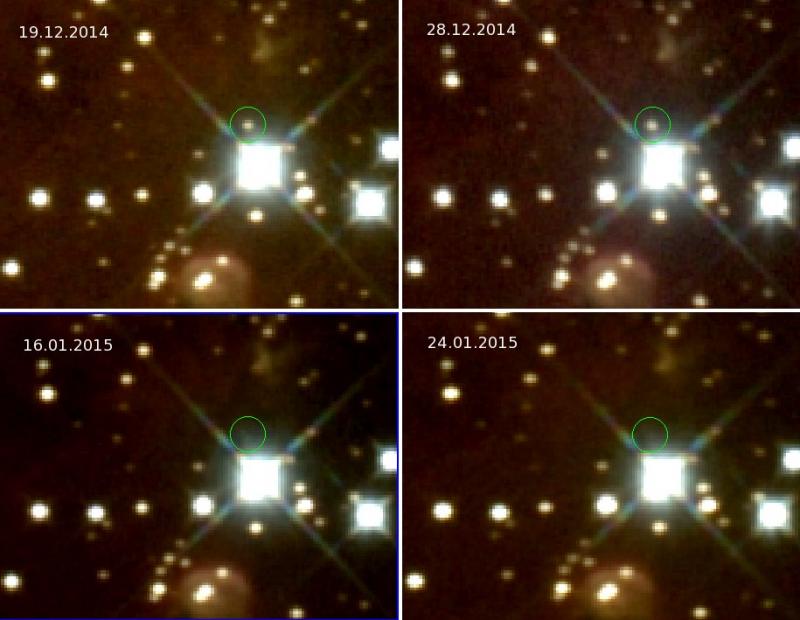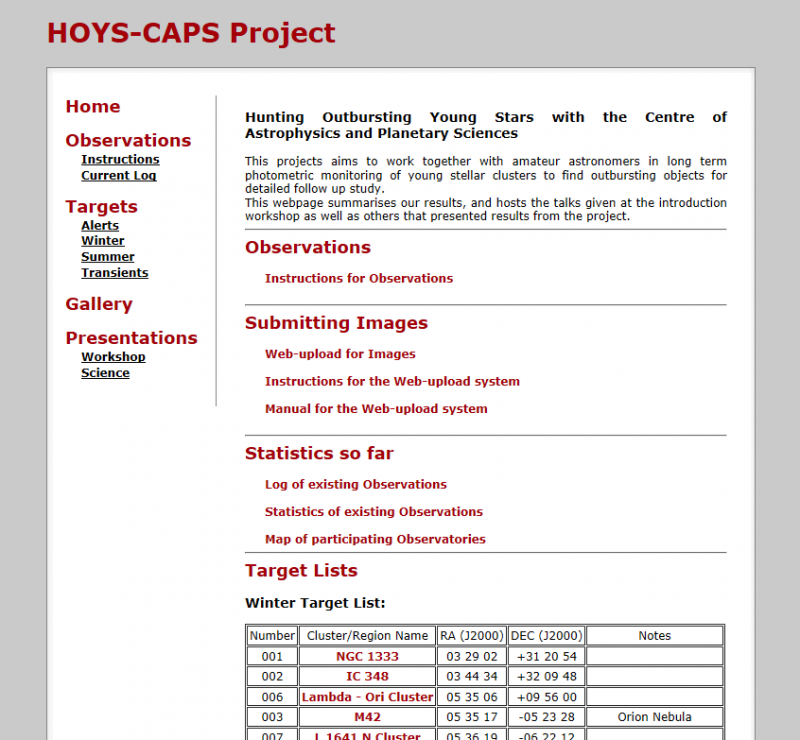2017 December 11
Hunting Outbursting Young Stars with the Centre of Astrophysics and Planetary Science
The University of Kent runs the HOYS-CAPS citizen science project since October 2014. The aim of the project is long term, multi-filter optical photometric monitoring of young (age less than 10Myr), nearby (distances typically within 1kpc) star clusters or star forming regions visible from the northern hemisphere. There are no restrictions given to the participants in terms of observing cadence, target priority, field of view, integration times or filter selection. The data is being used to study star formation and the formation of (terrestrial) planets in the disks surrounding young stars.
The project currently involves about 10 amateur astronomers from the UK, as well as from Europe and is supported by some additional professional observatories. The participants take images of objects on our target list, perform a basic data reduction (flat-fielding and dark/bias correction) and submit these reduced images for inclusion into our database via our newly developed web- interface http://astro.kent.ac.uk/HOYS-CAPS/. This interface will soon also allow participants to plot and study light-curves of any star imaged by the project. There is also a HOYS-CAPS Facebook Group for anyone who is interested in participating.

At the time of writing our target list contains 17 young clusters/regions as well as several additional targets selected from the Gaia Photometric Alerts http://gsaweb.ast.cam.ac.uk/alerts/alertsindex, some of which are within the 17 target regions. More than 3300 images have been taken for the project so far, with a total of about 1020 hrs of observing time. So far, the data has been included in one refereed paper, an Astronomers Telegram and a second paper is currently in preparation.

We are now aiming to increase the participation in HOYS-CAPS to a much larger number of amateur societies across the entire UK. Thus, if your society is interested in receiving a talk presenting in detail the scientific goals and results of this project and how to participate then please contact the PI (Dr Dirk Froebrich df@star.kent.ac.uk). We have secured travel funding from the University to support these talks, but would of course welcome a contribution to the travels cost in order to stretch the budget to as many talks as possible. We aim to give all these talks from April-December 2018. Hence, in your reply please let us know the following:
- Name and location of your Society;
- List of possible dates for the presentation;
- Number of members and number of people who would attend such a talk;
- Amount or fraction of the contribution your society would be able to make to the travel costs.
We will aim to make a schedule for these talks during the early parts of 2018. The selection of societies we will visit will only depend on the available dates. We only request the number of members for dissemination and the potential financial contributions for planning purposes.
Thank you very much for your interest in this project.
Dr. Dirk Froebrich, HOYS-CAPS PI
https://britastro.org/wp-content/uploads/2022/02/ngc2264_1st_rgb.jpeg
https://britastro.org/wp-content/uploads/2022/02/ngc2264_1st_rgb.jpeg
https://britastro.org/wp-content/uploads/2022/02/ngc2264_1st_rgb.jpeg
https://britastro.org/wp-content/uploads/2022/02/ngc2264_1st_rgb.jpeg
https://britastro.org/wp-content/uploads/2022/02/ngc2264_1st_rgb.jpeg
https://britastro.org/wp-content/uploads/2022/02/ngc2264_1st_rgb.jpeg
https://britastro.org/wp-content/uploads/2022/02/ngc2264_1st_rgb.jpeg
https://britastro.org/wp-content/uploads/2022/02/ngc2264_1st_rgb.jpeg
https://britastro.org/wp-content/uploads/2022/02/ngc2264_1st_rgb.jpeg
https://britastro.org/wp-content/uploads/2022/02/ngc2264_1st_rgb.jpeg
https://britastro.org/wp-content/uploads/2022/02/ngc2264_1st_rgb.jpeg
https://britastro.org/wp-content/uploads/2022/02/ngc2264_1st_rgb.jpeg
https://britastro.org/wp-content/uploads/2022/02/ngc2264_1st_rgb.jpeg
https://britastro.org/wp-content/uploads/2022/02/ngc2264_1st_rgb.jpeg
https://britastro.org/wp-content/uploads/2022/02/ngc2264_1st_rgb.jpeg
https://britastro.org/wp-content/uploads/2022/02/ngc2264_1st_rgb.jpeg
https://britastro.org/wp-content/uploads/2022/02/ngc2264_1st_rgb.jpeg
https://britastro.org/wp-content/uploads/2022/02/ngc2264_1st_rgb.jpeg
https://britastro.org/wp-content/uploads/2022/02/ngc2264_1st_rgb.jpeg
https://britastro.org/wp-content/uploads/2022/02/ngc2264_1st_rgb.jpeg
https://britastro.org/wp-content/uploads/2022/02/ngc2264_1st_rgb.jpeg
https://britastro.org/wp-content/uploads/2022/02/ngc2264_1st_rgb.jpeg
https://britastro.org/wp-content/uploads/2022/02/ngc2264_1st_rgb.jpeg
https://britastro.org/wp-content/uploads/2022/03/ngc2264_1st_rgb.jpeg
https://britastro.org/wp-content/uploads/2022/03/ngc2264_1st_rgb.jpeg
https://britastro.org/wp-content/uploads/2022/03/ngc2264_1st_rgb.jpeg
https://britastro.org/wp-content/uploads/2022/03/ngc2264_1st_rgb.jpeg
https://britastro.org/wp-content/uploads/2022/02/ngc2264_1st_rgb.jpeg
https://britastro.org/wp-content/uploads/2022/02/ngc2264_1st_rgb.jpeg
https://britastro.org/wp-content/uploads/2022/02/ngc2264_1st_rgb.jpeg
https://britastro.org/wp-content/uploads/2022/02/ngc2264_1st_rgb.jpeg
https://britastro.org/wp-content/uploads/2022/02/ngc2264_1st_rgb.jpeg
https://britastro.org/wp-content/uploads/2022/02/ngc2264_1st_rgb.jpeg
https://britastro.org/wp-content/uploads/2022/02/ngc2264_1st_rgb.jpeg
https://britastro.org/wp-content/uploads/2022/02/ngc2264_1st_rgb.jpeg
https://britastro.org/wp-content/uploads/2022/02/ngc2264_1st_rgb.jpeg
https://britastro.org/wp-content/uploads/2022/02/ngc2264_1st_rgb.jpeg
https://britastro.org/wp-content/uploads/2022/02/ngc2264_1st_rgb.jpeg
https://britastro.org/wp-content/uploads/2022/02/ngc2264_1st_rgb.jpeg
https://britastro.org/wp-content/uploads/2022/02/ngc2264_1st_rgb.jpeg
https://britastro.org/wp-content/uploads/2022/02/ngc2264_1st_rgb.jpeg
https://britastro.org/wp-content/uploads/2022/02/ngc2264_1st_rgb.jpeg
https://britastro.org/wp-content/uploads/2022/02/ngc2264_1st_rgb.jpeg
https://britastro.org/wp-content/uploads/2022/01/ngc2264_1st_rgb.jpeg
https://britastro.org/wp-content/uploads/2022/02/ngc2264_1st_rgb.jpeg
https://britastro.org/wp-content/uploads/2022/02/ngc2264_1st_rgb.jpeg
https://britastro.org/wp-content/uploads/2022/01/ngc2264_1st_rgb.jpeg
https://britastro.org/wp-content/uploads/2022/01/ngc2264_1st_rgb.jpeg
https://britastro.org/wp-content/uploads/2022/01/ngc2264_1st_rgb.jpeg
https://britastro.org/wp-content/uploads/2022/01/ngc2264_1st_rgb.jpeg
https://britastro.org/wp-content/uploads/2022/01/ngc2264_1st_rgb.jpeg
https://britastro.org/wp-content/uploads/2022/01/ngc2264_1st_rgb.jpeg
https://britastro.org/wp-content/uploads/2022/01/ngc2264_1st_rgb.jpeg
https://britastro.org/wp-content/uploads/2022/01/ngc2264_1st_rgb.jpeg
https://britastro.org/wp-content/uploads/2022/02/ngc2264_1st_rgb.jpeg
https://britastro.org/wp-content/uploads/2021/11/ngc2264_1st_rgb.jpeg
https://britastro.org/wp-content/uploads/2021/11/ngc2264_1st_rgb.jpeg
https://britastro.org/wp-content/uploads/2021/11/ngc2264_1st_rgb.jpeg
https://britastro.org/wp-content/uploads/2021/11/ngc2264_1st_rgb.jpeg
https://britastro.org/wp-content/uploads/2021/07/ngc2264_1st_rgb.jpeg
https://britastro.org/wp-content/uploads/2021/07/ngc2264_1st_rgb.jpeg
https://britastro.org/wp-content/uploads/2017/12/ngc2264_1st_rgb.jpeg
https://britastro.org/wp-content/uploads/2017/12/kh15d.jpeg
https://britastro.org/wp-content/uploads/2022/02/ngc2264_1st_rgb.jpeg
https://britastro.org/wp-content/uploads/2022/02/ngc2264_1st_rgb.jpeg
https://britastro.org/wp-content/uploads/2022/02/ngc2264_1st_rgb.jpeg
https://britastro.org/wp-content/uploads/2022/02/ngc2264_1st_rgb.jpeg
https://britastro.org/wp-content/uploads/2022/02/ngc2264_1st_rgb.jpeg
https://britastro.org/wp-content/uploads/2022/02/ngc2264_1st_rgb.jpeg
https://britastro.org/wp-content/uploads/2022/02/ngc2264_1st_rgb.jpeg
https://britastro.org/wp-content/uploads/2022/02/ngc2264_1st_rgb.jpeg
https://britastro.org/wp-content/uploads/2022/02/ngc2264_1st_rgb.jpeg
https://britastro.org/wp-content/uploads/2022/02/ngc2264_1st_rgb.jpeg
https://britastro.org/wp-content/uploads/2022/02/ngc2264_1st_rgb.jpeg
https://britastro.org/wp-content/uploads/2017/12/kh15d.jpeg
https://britastro.org/wp-content/uploads/2022/02/ngc2264_1st_rgb.jpeg
https://britastro.org/wp-content/uploads/2022/02/ngc2264_1st_rgb.jpeg
https://britastro.org/wp-content/uploads/2022/02/ngc2264_1st_rgb.jpeg
https://britastro.org/wp-content/uploads/2022/02/ngc2264_1st_rgb.jpeg
https://britastro.org/wp-content/uploads/2022/02/ngc2264_1st_rgb.jpeg
https://britastro.org/wp-content/uploads/2022/02/ngc2264_1st_rgb.jpeg
https://britastro.org/wp-content/uploads/2022/02/ngc2264_1st_rgb.jpeg
https://britastro.org/wp-content/uploads/2022/02/ngc2264_1st_rgb.jpeg
https://britastro.org/wp-content/uploads/2022/02/ngc2264_1st_rgb.jpeg
| The British Astronomical Association supports amateur astronomers around the UK and the rest of the world. Find out more about the BAA or join us. |
